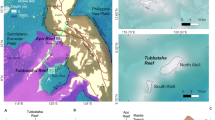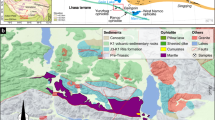Abstract
Three regions can easily be identified in the study area according to the Middle Permian palaeobiogeographic distribution of biota, they are the southern slope of East Kunlun, A’nyêmaqên and Bayan Har. Biotic constitution and ecology in the southern slope of East Kunlun and Bayan Har are very similar. Both the diversity and abundance of organisms in these two areas are very high and reefs are widely developed. However, biotic diversity and abundance in A’nyêmaqên which is between the above two areas are obviously low. Differentiation of palaeobiogeographic distribution in these areas should be due to the baring of A’nyêmaqên ocean in the time of Middle Permian. Middle Permian radiolarian chert and thick abyssal red ooze are widely spread in A’nyêmaqên, implying that the A’nyêmaqên ocean had a great scale in size. Vast scale of deep ocean basin became an impassable gulf for some of the benthos, and as a result, only part of the organisms could have the chance to get to the isolated islands situated in ocean basin. Small living space and hard conditions in the islands further limited the abundance and diversity of biota. Tectonic background reflected by the geochemical study of basalt in the three areas is coupling well enough with the palaeobiogeographic division.
Similar content being viewed by others
References
Liu Xun, Fu Derong, Yao Peiyi et al., The stratigraphy, paleobio-geography and sedimentary-tectonic development of Qing-hai-Xizang (Tibet) Plateau in light of terrane analysis, Geological Memoirs, Ser.2, No. 15 (in Chinese with English abstract), Beijing: Geological Publishing House, 1992, 38–77.
Bureau of Geology and Mineral Resources of Qinghai Province, Regional Geology of Qinghai Province, Geological Memoirs, Ser.1, No.24 (in Chinese with English abstract), Beijing: Geological Publishing House, 1991, 6–7.
Wang Guocan, Liang Bin, Zhang Tianping et al., Tectonic reposition of non-Smith stratigrapgy in orogenic belt: Exemplified by the East Kunlun orogenic belt, Regional Geology of China (in Chinese), 1998, (supplement): 25–30.
Wang Yongbiao, Xu Guirong, Lin Qixiang et al., Depositional model of early Permian reef-island ocean in Eastern Kunlun, Science in China, Ser. D, 2001, 44(9): 808–815.
Jiang Chunfa, Yang Jingsui, Feng Binggui et al., Opening closing tectonics of Kunlun Mountains, Geological Memoirs, Ser.5, No.12(in Chinese with English abstract), Beijing: Geological Publishing House, 1992, 141–152.
Wang Hongzhen, He Xinyi, Chen Jianqiang et al., Classification, Evolution and Biogeography of the Palaeozoic Corals of China (in Chinese with English abstract), Beijing: Science Press, 1989, 188–191.
Zhang Kexin, Huang Jichun, Yin Hongfu et al., Application of radiolarians and other fossils in non-Smith strata: Exemplified by the A’nyêmaqên melange belt in East Kunlun Mts., Science in China, Ser. D, 2000, 43(4): 364–374.
Bian Qiantao, Luo Xiaoquan, Li Hongsheng et al., Discovery of early Paleozoic and early Carboniferous to early Permian ophiolite, Geol. Sci. (in Chinese with English abstract), 1999, 34(4): 523–524.
Liu Benpei, Feng Qinglai, Pgn Fang Nianqiao et al., Tectonic evolution of Paleo-Tethys poly-island-ocean in Changning-Menglian and Lancangjiang belts, southwestern Yunnan, China, Earth Science (in Chinese with English abstract), 1993, 18(5): 529–539.
Laboratory of Paleontology, Wuhan College of Geology, Paleontology (in Chinese), Beijing: Geological Publishing House, 1980, 50–83.
Barry, C. C., Peter, D. M. (translated by Zhao Tieqiao, Yang Zhengben), Biogeography (in Chinese), Beijing: Higher Education Press, 1985, 137–164.
Yang Jingsui, Division of the Kunlun ophiolite belts and their main characteristics, In Opening closing tectonics of Kunlun Mountains (eds. Jiang Chunfa, Yang. Jingsui, Feng Binggui et al.), Geological Memoirs, Ser. 5, No.12, (in Chinese with English abstract), Beijing: Geological Publishing House, 1992, 138–139.
Hou Guangjiu, Zhu Yunhai, Zhang Tianping et al., Lithogeo-chemical features of basalt and its tectonic environment analysis in the area of Tuosuo Lake in the orogenic belt of East Kunlun, Regional Geology of China, (in Chinese), 1998, (suppl.): 31–37.
Zhu Yunhai, Zhang Kexin, Example of the Facies Analysis of non-Smith Strata in Orogenic Belt, in Theory, Methods and Practice: Exemplified by the East Kunlun Orogenic Belt (eds. Zhang Kexin, Yin Hongfu, Zhu Yunhai et al.) (in Chinese), Wuhan: China University of Geosciences Press, 2001, 80–102.
Author information
Authors and Affiliations
Corresponding author
Rights and permissions
About this article
Cite this article
Wang, Y., Yang, H. Middle Permian palaeobiogeography study in East Kunlun, A’nyêmaqên and Bayan Har. Sci. China Ser. D-Earth Sci. 47, 1120–1126 (2004). https://doi.org/10.1360/02yd0450
Received:
Issue Date:
DOI: https://doi.org/10.1360/02yd0450




